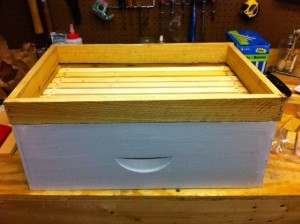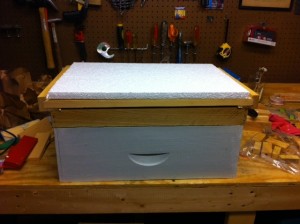Kim and Bob joined us for pizza last night, but before we headed out we headed down into their basement where Bob keeps his shop. We wanted to see the progress on his top-bar hives. Well, they’re as good as finished…and, I must admit, they’re really wonderful.
Bob found some plans online that he liked and built two hives from scrap lumber (I’ll ask him for the site address so I can link it here). I don’t think these took him long to build, but then, he’s sort of a professional at these things. It would probably take me an eternity. And much aggravation. But, as you can see here, it doesn’t seem to have challenged Bob all that much.

Bob plans on painting the hives (I told you he’s sort of particular) because the material he used wasn’t designed for holding up outside. They’re gonna be green…the color of their leftover house paint…which is two gorgeous shades of green. I’ll post a picture of the finished hives when we introduce the bees to it, okay? But this is what it looks like right now:












